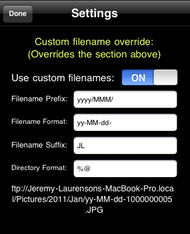Okay, so you want the files named exactly the way you would like, put in directories of your choosing too... This is why we wrote MediaTransfer... and why some complain its too difficult to set up. You know what youre doing with FTP, and you want it to do your bidding...
To do this, MediaTransfer has the Custom filename override section, and uses that in conjunction with your ftp:// path...
The Directory Format as well as Filename format strings are really Unicode Date patterns - this lets you use date formatters to make the directories and filenames whatever you want.
Click here to view the full set of date patterns that you can use to build filenames and dates.
For individual serial numbers or unique IDs for each item there are two special codes you can put into the "Filename Suffix" field. These insert a unique or pseudo-unique ID into the filename:
Entering %@ in the Filename Suffix will enter a unique ID, constant at that point. This ID is based on the internal ID of the file in iOS, so if you clear all uploaded entries and upload them all again, the filenames will be consistent and files will overwrite their old versions.
Entering a %N will enter a unique 5 digit serial number that keeps incrementing. This will ensure unique names, but if you "clear uploaded items" it will create duplicates when you upload again since this number is NOT related to the actual file, but is instead simply the count of the number of files uploaded.
So lets see this in action for a file created 12/22/2010:
Ftp Path: www.myserver.com/incoming/
Directory Format: yyyy-MM/dd/
Filename Prefix: JL
Filename Format: ddMMyy-
Filename Suffix: %@-%N-iPhone
Results in:
ftp://www.myserver.com/incoming/2010-12/22/JL221210-10000000001-00000-iPhone.JPG
All non-letter character represent themselves in a pattern, except for the single quote. It is used to 'escape' letters. Two single quotes in a row, whether inside or outside a quoted sequence, represent a 'real' single quote.

